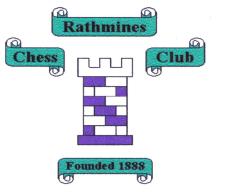Jack has annotated a couple of his games for the website. He decided to annotate his only serious game against Philip Hogarty, in his honor. I want to include as many games as possible from Philip, so if you have any games, please send them to me at scannell_tony@yahoo.co.uk. Thanks.
Jack: I only played Philip Hogarty once in a serious game. It happened in the 2007 Rathmines Club Championship. The game itself was in round 2 and was played on 24th April 2007. I had lost my first round game as white and so was rather defensively minded.
Philip Hogarty (White) vs. Jack Killane (Black)
Rathmines Senior Club Championship, 2007.
1. e4 e5 2. Nf3 Nc6 3. Bc4 Nf6

The Two Knights Defence, which I have had often as both black and white. 3… Nf6 is more active than 3…Bc5.
4. d4 White has two main choices. (1) Ng5 – the old move, attacking f7. Black is almost forced to play 4…d5 and then usually 5…Na5. Black can play 4…Bc5, which is the Traxler or Wilkes-Barr, which is very hairy…
4… exd4 5. 0-0 Nxe4 6. Re1 d5 7. Bxd5

A temporary, pseudo-sacrifice 7… Qxd5 8. Nc3 Qa5 This is better than Qh5
9. Nxe4 Be6 10. Neg5 0-0-0 11. Nxe6 fxe6 12. Rxe6 Bd6 13. Bg5 Rde8

All this is book/theory. Most usual now is 14. Qe2 Kd7 15. Re1 but black can play Qxe1+ 16. Qxe1 Rxe6 where black has two rooks for a queen and may be better.
14. Qe1 Qxe1+ 15. Raxe1 Kd7 16. Rxe8 Rxe8 17. Kf1 Rxe1+ 18. Kxe1 Ke6 19. Ke2 Kd5 20. a3 Ne5 21. Nxe5 Bxe5 22. Bd2 c5 and draw agreed.

After 22. …c5
Here I offered a draw which Philip accepted. Philip felt black had the better game because of his queen-side majority and his better-placed king. But white has a potential passed pawn on the king-side and having lost in the first round as white, I was anxious to get a score on the board.
Little did I know it would be the first and last time I would play Philip.
Armstrong Cup Round 5, Board 5
Gonzaga vs. Rathmines B, 29 November 2007.
Jack Killane (Rathmines) vs. Eoghan Casey (Gonzaga)
1. e4 c5 2. Nf3 I played Eoghan Casey in the Armstrong several years ago, also as white. I played the Morra Gambit 2. d4 cxd4 3. c3 dxc3 and eventually lost. So I decided to change.
2… d6 3. d4 cxd4 4. Nxd4 Nf6 5. Nc3 g6

The Dragon Variation of the Sicilian. One of the most aggressive lines for black, along with the Najdorf, 5.a6. I used to play the Dragon many years ago but after some heavy defeats abandoned it.
6. Be3 Bg7 7. f3 0-0 8. Qd2 Nc6

White plays the Yugoslav Attack, an attacking line. White intends to castle queenside, play h2-h4-h5, open the h-file and mate black. See Fischer’s dismissive comments on the Dragon in the game Fischer-Larsen in his masterpiece, My 60 Memorable Games. The most usual move now is 9. Bc4. However as I was somewhat rusty in the opening, I played the alternative 9. 0-0-0 which was probably a mistake.
9. 0-0-0?! d5! 10. Nxc6 bxc6 11. Bd4 e6 12. h4?

A very bad move. White should have realised that the nature of the game has changed.
12… Qa5 13. Kb1 dxe4 14. Nxe4 Qxd2 15. Rxd2 e5 16. Nxf6+ Bxf6 17. Bc5 Re8 18. Bc4 e4 19. Re2 Bf5 20. fxe4 Rxe4 21. Rxe4 Bxe4 22. Rf1 Rd8 23. a3 Rd2 24. Bb3 Bxh4 25. Rxf7 Bd5

I thought black should have played Bxc2 but 26. Kc1 is good for white.
26. Rxa7 Bxb3 27. cxb3 Rxg2

White’s incautious 12. h4 has resulted in the pawn’s loss. Black, I think, is winning because he can get his kingside passed pawns moving quickly while white’s queenside pawns are doubled.
28. a4 Bf6 29. b4 h5 30. Rd7 h4 31. Rd3 Rxb2+ 32. Kc1 Ra2 33. a5 g5 34. Kb1 Ra1+ 35. Kc2 g4 36. Bd6 g3 37. Bxg3

I was happy to give up the bishop for the two passed pawns. 37 …hxg3 38. Rxg3+ Kf7 39. Re3 Ra2+ 40. Kb3 Rb2+ 41. Ka3 Rb1

The ending is interesting. White’s strategy is to keep black’s king from getting through to the queenside and to get rid of black’s last pawn for his own 2 pawns to leave a rook + bishop vs. rook ending which is gradually drawn but can be tricky (verify for yourself). Black’s plan is to achieve the opposite. No further comments are given as both player’s were getting short of time.
42. Ka4 Be7 43. Re4 Ke8 44. Rd4 Bf8 45. Ka3 Bg7 46. Rd6 Rc1 47. Rg6 Kf7 48. Rd6 Ke7 49. Rg6 Be5 50. a6 Ra1+ 51. Kb3 Bf6 52. Kc4 Kf7 53. Rh6 Kg7 54. Rh5 Rxa6 55. b5 Ra5 56. Kb4 Rxb5+ 57. Rxb5 cxb5 58. Kxb5 ½- ½
Not a perfect game, but a well-fought won, typical of league chess.


Pingback: Cork Chess review « Rathmines Chess Club